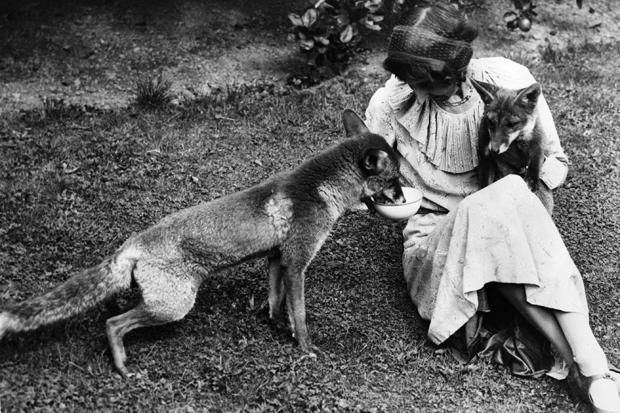Have you ever considered tying a fox’s penis to your head? Well no, nor have I, but if you suffer from migraines, perhaps you might give it a shot. The fox, in fact, was thought to be a cure for any number of maladies in the 1600s. Fox ashes dunked in wine were recommended as a cure for asthma, their brains were thought to be useful in treating epilepsy, and making a necklace of fox testicles for a child was billed as a surefire cure for toothache. It sounds like quite the fashion statement.
This book — Lucy Jones’s first — is a fascinating discussion of the history of our attitude to the fox, and if you want to know more about the red creature that wakes you at 3 a.m. with its baby-like screaming, then this volume is sure to keep you occupied for a while at least. It’s certainly interesting to learn how our attitude to the animal has altered. The author thanks Roald Dahl and his Fantastic Mr Fox for changing our perception of the fox from crafty trickster to hero. After all, if you look at 19th- and 20th-century literary depictions of foxes — or even back to Aesop and the Bible — they are almost always seen as dangerous, crafty and clever. Consider the way we use phrases such as ‘cunning as a fox’ or ‘you sly fox’. Even now our language depicts them as being intelligent but untrustworthy.
But while Jones highlights the fact that foxes have always been respected for their craftiness, the entertaining ways in which they were used in the 1600s didn’t exactly demonstrate that respect. Fox-tossing was a popular pastime in which a fox (or another animal — wildcats, badgers and hares were also popular props) was bounced high into the air off a tight piece of material. Twenty-four feet was considered a jolly good attempt; not many of the animals survived. One festive dinnertime entertainment between courses in the Inner Temple involved releasing a cat and a fox and setting hounds after them.
Unsurprisingly, as well as recounting the history of the British people’s relationship with foxes, Jones also covers the more recent politics of the hunting debate. For the majority of people, this is the one aspect of the fox that they know the most about — so perhaps it didn’t need as much attention as Jones gives it. She does, however, try her best to grasp both sides of today’s fox-hunting debate, travelling to Blencathra in the Lake District to spend the day with a foot pack there and their aptly named huntsman Barry Todhunter (‘tod’ being a proverbial name for a fox).
The author also rises early one morning to go out ‘sabbing’, but it’s in this chapter that things become confusing. She claims to be perplexed as to why the hunt were annoyed to see anti-hunt protestors out with them when the sabs, as she puts it, ‘weren’t physically preventing any riding or causing any harm’. But she’s already revealed that they had with them audio players ‘containing recordings of hounds and horns to confuse the proceedings’. Surely, by distracting the hounds from the pre-laid scent they are supposed to be following, the sabs spoiled the day enough for the hunt to be irritated.
But of course, foxes are mainly spotted these days in urban environments rather than surrounded by hounds and horses. It’s interesting to learn that the phenomenon of the urban fox only began in 1940s — when they were appreciated (in the Daily Mail) for their beetle- and rat-eating habits. Only in the 1990s did they start to be seen as an urban pest rather than a handy rodent assassin, with stories of attacks on children in their beds making for lurid headlines.
This book’s subtitle — ‘A Story of Love and Loathing in Modern Britain’ — makes our view of the fox sound like a black-and- white issue. But as Jones discovers, that’s far from being the case. We meet a pest- controller who kills foxes for a living but has a pet one at home; and are informed that ‘most purist fox hunters spend half the year hunting foxes and half the year preserving them’ — and express admiration for their beauty and intelligence.
The fox certainly has a place in many people’s hearts, and anyone who has seen one in the wild will understand why. They’ve been in the British Isles for over 130,000 years so it’s not surprising that people have developed strong opinions about them. This book might not change your view about the fox, but it will almost certainly teach you something new.







Comments